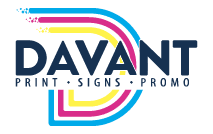Photo Credit: https://www.pexels.com/photo/person-using-macbook-209151/
Competing for eyeballs in today’s marketing-heavy society can be a little overwhelming. Trends are coming and going almost overnight, and marketers worldwide are testing new design boundaries and limits. With so many design applications and websites now available to your team, you might be wondering how you can get your message across and stand out from the crowd.
It all starts with balance. Whether you’re putting together a flyer, a sign, mailers, or a social media graphic, the basic design principle of balance and page composition should always be at the forefront of your mind. Page composition is the process of placing and rearranging design elements on a page. With the right arrangement, you can attract eyes and still get your message across in a short amount of time. Here at Davant Indy, we pride ourselves on helping clients with their designs, finding harmony and balance while creating stunning marketing artworks. Here is how you, too, can practice creating a balanced page layout.
Build Up Your Education
Sitting down to design something is not always an easy task, so it’s always best to remember your designer roots and the history of where design started. Design is a constant flow, and styles evolve through the years. So, even if you have a college degree and several years of experience under your belt, it’s wise to keep up with the latest trends and shifts in design theory.
Even today’s modern designs are a play on 20th-century minimalism, but that doesn’t mean this concept is easy to master. Through reading, researching, and practice, you can build upon your skills and continue to increase your education about design that will continue to help you along in your career.
Define Your Purpose
Now that you have a basic understanding of the history and latest trends, it’s time to think about your marketing piece’s purpose. Every asset you or your team create should have a clear and concise mission. Many marketers like to use the who, what, why, and how method. Answering these simple questions for each page will ensure that you create a balanced layout with a clear mission.
When you define the who, what, why, and how, you can begin to think clearly and be more focused on what the final balanced page layout should look like. If you ever feel lost or overwhelmed in the process of design, you can then come back to these objectives for a quick reminder of what you’re trying to accomplish.
Create Harmony
Consumers will only ever see the finished page layout, hardly appreciating the hard work, time, and thought that went into your flyer or mailer, but that doesn’t mean you should put any less thought into the process. Creating a more balanced page layout involves two elementary design tools: a grid and the right font pairings.
Using the grid format will help you with visual direction, concept, and established hierarchy within your page. Additionally, a grid’s purpose is to help you align elements on the page so you can create a flow of visuals and a balanced text-to-art ratio. With the grid, you can also clearly see where your page is lacking aesthetically, and this will help you pair your fonts correctly. Pairing the wrong fonts with each other will hurt your page’s statement and be off-putting to your audience. Try to remember to use dramatic fonts as headers and easier-to-read fonts as body text.
Upload Your Design
Davant Indy is your go-to printer and designer, whether you need fliers in bulk or a sign for an upcoming announcement. Our expert team of designers know how to create a balanced page layout, and we’re here to help you with all of your marketing needs. So, upload your file today to get started, or give us a call at (317) 849-6565.

